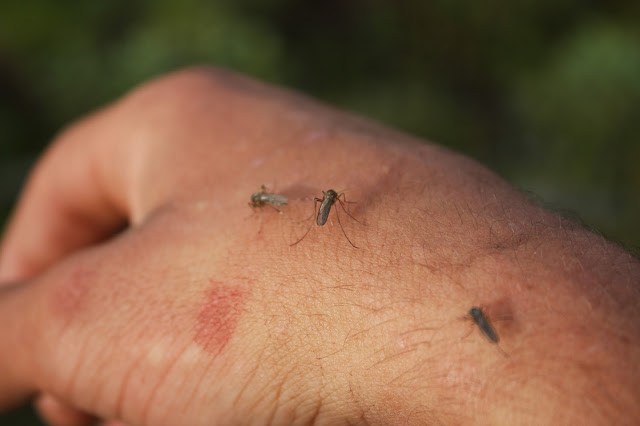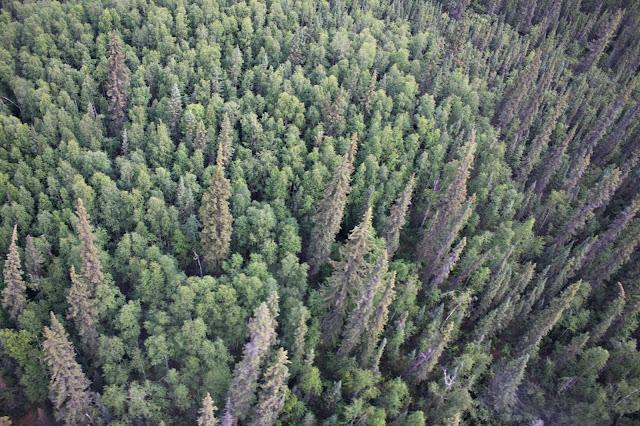Before heading off to our latest stint, I had a few days to catch some rest at Coal Creek Camp. One of the boaters that I mentioned in the previous post told me that he was up at 2am and saw a wonderful "sunset". I decided I would make the effort, and boy was it worth it. The sky and river seemed to be aflame. An absolutely tremendous scene.
Rachel and I decided to check out the massive Coal Creek Dredge just over a mile upstream from Slaven's Roadhouse. The dredge was most recently active in the 1970's, but has been around for almost 100 years.
You are free to walk around inside. All the shelves are still full of supplies, and it seems as if you could just flick a switch and get the whole thing started again. Randy, a very helpful and friendly ranger, who was working at the camp, stopped by and gave us a tour, explaining how the gigantic machine actually worked to pull out thousands of pounds of gold and silver.
I struggle to maintain control of the machine.
In the afternoons when the temperature crept to its highest point of the day, I found the silty waters of the Yukon refreshing.
My last day at Coal Creek I meandered down an old mining road and ended up on an unofficial birding trip. Above, violet-blue swallows swoop, dive and chase each other around like crazy. When they sat still (which was not often) you could snatch a glimpse of their emerald backs shimmering in the sunlight.
The hillsides came alive with the wind. The tree above, Latin name Populus tremuloides, known as Quaking Aspens, have leaves attached to the branches by flat petioles which allow the leaves to quickly flutter in the wind. I was told the "tremul" portion of the Latin name refers to this "trembling" movement.
This massive bird glided smoothly overhead. I spent a lot of time with a bird book back at the roadhouse attempting to deduce what species it could be. Alas, no bird in the book perfectly matched the coloration and demarcations of this individual, and I decided that it seemed most similar to a rough-legged hawk.
This bird alighted on a nearby branch. However my basic ornithological knowledge stops at robin, eagle, and crow...so I do not know what bird this is. Feel free to let me know!
The rest of the crew arrived from Fairbanks on Monday morning and we began the helicopter shuttling process to get both teams' personnel and gear to their respective locations. As always, we had a good laugh at the sight of Fleur in an XXL flightsuit.
An old-school edit of a landscape we flew over on the way to our work site.
Well, this picture about sums up the past ten days. Mosquitoes 24/7. It was a bummer as the location was pretty, and despite a few rough weather days and some grueling hiking, the trip could have been awesome if these guys hadn't been around. Swarms of thousands followed us from the instant we left our tents in the morning to the moment we jumped back in at night. The photo above was taken the second night. I kept killing them by the hundreds and by the end of the stint, an estimated 4,000 had accumulated between the rain fly and screen roof of my tent.

These fellas don't seem to mind some DEET.
Apart from the mosquitoes the trip was excellent. Our campsite was on a gravel bar in a big bend in Washington Creek. Thousands of moose prints were in the immediate area, and on two separate occasions we awoke to a massive animal crashing through camp.
The first day of work, we crossed the stream right next to camp, scaled the steep bank and were greeted with a wonderful sight...blueberries! As I was to quickly find out, this was no isolated patch of berries. Everywhere we hiked there were berries by the hundreds. In some locations small areas of land appeared blue due to their density and size. And, they were delicious.
I collected a few handfuls on the way back from our last plot one night and we dined on them for dessert. The bright orange berries you see are one of my personal highlights from the trip. They are called cloudberries. I had never heard of them before, and I don't know how this was possible. They grow individually making it hard to collect multitudes easily, but they taste like a mango citrus smoothie...absolutely delectable.
Can't forget the raspberries! These were growing just feet from our tent, and were also perfectly ripe and tasty.
Who says you can't eat well in the Alaskan wilderness?! Above, one of the dinners I prepared for the team. On the menu for the night, penne alfredo with sundried tomatoes and peppered salami.
This photo is a fairly good representation of the hiking we faced each day. Either we were bushwhacking through extremely thick stands of spruce and birch, or we were crossing vast fields of tussocks. Now, tussock hiking was a new experience for me. Certain grasses and shrubs grow on top of what is called permafrost (soil that is inundated with water and frozen year-round), and these plants grow on top of themselves to create endless landscapes of these tussocks. They are often as tall as 3 feet, and hiking among them is hellacious. With every step you struggle to balance, we were falling left and right, and I am sure our heavy packs weren't helping at all.
Here I am, a little delirious after a 13 hour work day filled with rain and mosquitoes. Apparently these mosquitoes don't mind heavy rain or sweltering heat as I have been told are their kryptonite.
Cool mist flowing through the valley one early morning.
The only haven from mosquitoes (apart from sleeping at night after slaughtering all the ones that managed to get into your tent) was by taking a nice, cool swim in the stream near camp. The water was perfect, and you really didn't want to come out knowing what was waiting for you on shore.
Waiting for our ride out. Top Gun style.
A view from the helicopter as we rise straight upwards from our campsite.
On the way back to the Coal Creek airstrip we flew over the Charley River which is both part of the preserve's name, and the location where the other crew was stationed.
A little blurry due to my last second attempt to snap the photo, but you can see a big ol' moose hanging out in a boggy area we flew over.
No other feeling like being in a helicopter flying low over the trees.
At Coal Creek, we unloaded all of our gear and then began the final leg of our trip back to Fairbanks. And for Rachel and I, our first time out of the preserve in six weeks.
The plane ride was equally as enjoyable. From Coal Creek, we had to fly over much of the park. The views of the Yukon River and surrounding mountain landscapes were humbling.
Ridges, peaks, valleys, and streams galore. We even spotted caribou and a grizzly. I was continually impressed with the sheer vastness of untouched land.
Everyone loves a good rainbow.
Large swaths of sphagnum moss splash some striking red coloration across the landscape.
Clearly visible from above (and annoyingly hard to find when on the ground), paths worn into the slopes by animals create natural highways. We were always pleased to find a good moose path through the tundra. Too bad they never seem to go exactly where we needed to!
Curtis, our pilot, cruised just below the fairly low clouds. Here and there the majestic mountains disappeared above us.

















































